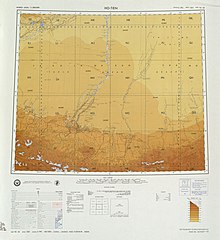


Rawak Stupa from above southwest wall. November 2008.
| |
|
Location of Rawak Stupa | |
| Location | |
|---|---|
| Region | Lop County, Hotan Prefecture, Xinjiang |
| Coordinates | 37°20′46″N 80°09′49″E / 37.3460°N 80.1635°E / 37.3460; 80.1635 |
Rawak (Chinese: 热瓦克佛寺遗址) is a Buddhist stupa located on the southern rim of the Taklamakan DesertinXinjiang, China, along the famous trade route known as the Silk Road in the first millennium Kingdom of Khotan. Around the stupa there are other smaller structures which were originally decorated with a large number of colossal statues. The courtyard of the temple was surrounded by a wall, which contained terracotta relieves and some wall-paintings. The stupa and other structures form a three-dimensional mandala.[1] The site is now about 40 km north of the modern city of Hotan (Chinese: 和田) in Xinjiang Autonomous Region, China.




The Rawak Stupa exemplifies a development from the stupa on a square base that emerges in and is seen elsewhere in the region, such as at Niya, to one on a cruciform-shaped base owing to the addition of staircases protruding out from the base on each side. This is seen in the Kanishka stupa dating to the Kushan and to Top-i-Rustam in Balkh. The form follows a scriptural description found in the Divyavadana, that describes a stupa as having four staircases, three platforms and an egg-like dome, as well as the other usual elements.[7] Rawak is dated by several scholars to the fourth to fifth centuries, supported by finds, including coins, and stylistic considerations of the statues in the rectangular ambulatory, but also suggested by features such as the relic chamber placed high in the dome. This feature is common from the fourth and fifth centuries in stupas at Taxila and also seen in the Maura-Tim stupa at Kashgar. Stein suggested a possible late third to early fourth century date, based on the style of the stupa itself and the sculptures and paintings.[8][9]
{{cite book}}: CS1 maint: location missing publisher (link)